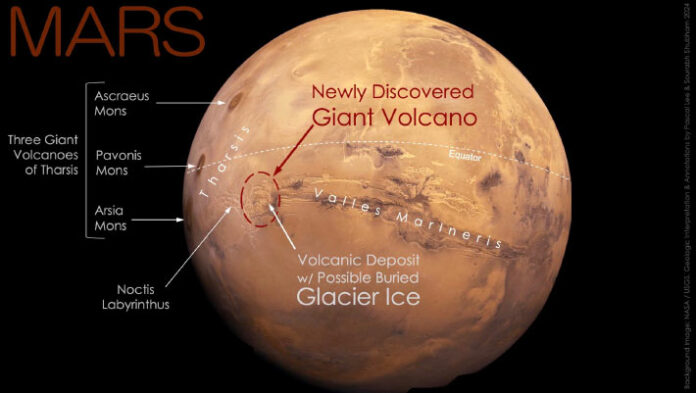Provisionally designated Noctis Mons, the newly-discovered volcano is located just south of Mars’ equator, in Eastern Noctis Labyrinthus, west of Valles Marineris, the planet’s vast canyon system.
Noctis Mons reaches 9,022 m (29,600 feet) in elevation and spans 450 km (280 miles) in width.
Its gigantic size and complex modification history indicate that it has been active for a very long time.
In its southeastern part lies a thin, recent volcanic deposit beneath which glacier ice is likely still present.
This combined giant volcano and possible glacier ice discovery is significant, as it points to an exciting new location to study Mars’ geologic evolution through time, search for life, and explore with robots and humans in the future.
“We were examining the geology of an area where we had found the remains of a glacier last year when we realized we were inside a huge and deeply eroded volcano,” said Dr. Pascal Lee, a planetary scientist with the SETI Institute and the Mars Institute based at NASA Ames Research Center.
Several clues, taken together, give away the volcanic nature of the jumble of layered mesas and canyons in this eastern part of Noctis Labyrinthus.
The central summit area is marked by several elevated mesas forming an arc, reaching a regional high and sloping downhill away from the summit area.
The gentle outer slopes extend out to 225 km (140 miles) away in different directions.
A caldera remnant — the remains of a collapsed volcanic crater once host to a lava lake — can be seen near the center of the structure.
Lava flows, pyroclastic deposits (made of volcanic particulate materials such as ash, cinders, pumice and tephra) and hydrated mineral deposits occur in several areas within the structure’s perimeter.
“This area of Mars is known to have a wide variety of hydrated minerals spanning a long stretch of Martian history,” said Sourabh Shubham, a graduate student at the University of Maryland.
“A volcanic setting for these minerals had long been suspected. So, it may not be too surprising to find a volcano here.”
“In some sense, this large volcano is a long-sought smoking gun.”
In addition to the volcano, the authors discovered a 5,000-km2 (1930 square mile) area of volcanic deposits within the volcano’s perimeter presenting a large number of low, rounded and elongated, blister-like mounds.
This blistered terrain is interpreted to be a field of rootless cones, mounds produced by explosive steam venting or steam swelling when a thin blanket of hot volcanic materials comes to rest on top of a water or ice-rich surface.
Noctis Mons presents a long and complex history of modification, possibly from a combination of fracturing, thermal erosion, and glacial erosion.
“It’s really a combination of things that makes the Noctis volcano site exceptionally exciting,” Dr. Lee said.
“It’s an ancient and long-lived volcano so deeply eroded that you could hike, drive, or fly through it to examine, sample, and date different parts of its interior to study Mars’ evolution through time.”
“It has also had a long history of heat interacting with water and ice, which makes it a prime location for astrobiology and our search for signs of life.”
“Finally, with glacier ice likely still preserved near the surface in a relatively warm equatorial region on Mars, the place is looking very attractive for robotic and human exploration.”
The researchers presented their findings today at the 55th Lunar and Planetary Science Conference in The Woodlands, Texas, the United States.
_____
Pascal Lee et al. Large eroded volcano complex and buried glacier ice in eastern Noctis Labyrinthus: evidence for recent volcanism and glaciation near Mars’ equator. LPSC 2024, abstract #2745



